In a great transition, we cut from the bright and colorful ruins of Cair Paravel to the grim looking Telmarine castle. OK, I admit it’s not very original to give the good guys bright colors and the bad guy’s darker ones, but it works here. And while the contrast isn’t subtle, the muted colors the Telmarines aren’t as much of a villain cliche as them wearing black would be. All of the scenes at the Telmarine court have a very chilly, gray, gritty atmosphere that contrasts wonderfully with the lush, storybook aesthetic of the Narnians.
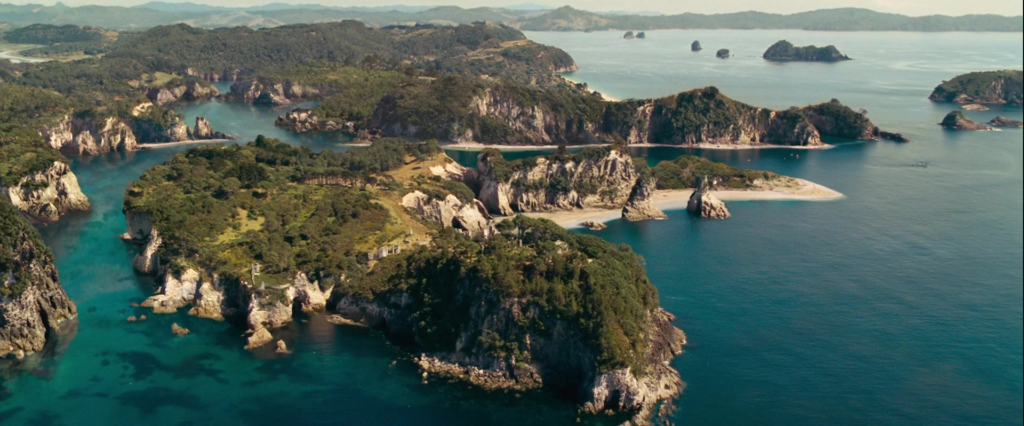
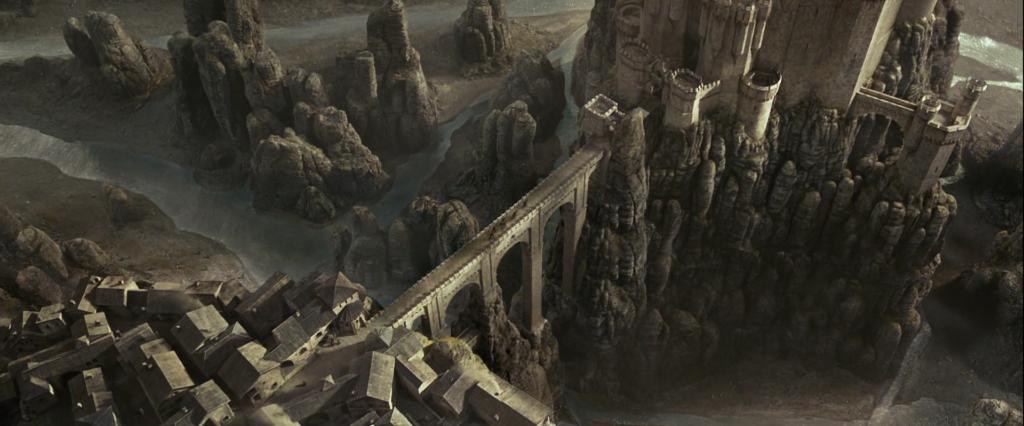
If I have a problem with the Telmarine aesthetic in this adaptation, it’s that it’s a bit too visually interesting. How can that be?
In keeping with what Aslan tells us about the Telmarines’ history at the end of this story, the filmmakers gave their culture a broadly Mediterranean feel and cast mainly Spanish and Italian actors in their roles.[1]Many of whom are famous in their own countries but not in the UK or the US. For what it’s worth, I think this makes a pleasing change of pace from the first movie which had a mostly English cast with a few Americans thrown in the mix. The cinematic Telmarines’ armor also suggests that of the conquistadors, probably as a nod to their history of invasion and conquest. I’m a bit bemused by the decision though. Later books in The Chronicles of Narnia have been criticized for making the villainous country of Calormen generically Middle Eastern/Oriental in its culture. The literary Telmarines, by contrast, were clearly intended by C. S. Lewis to be generically European. You’d think the filmmakers would be relieved by the opportunity to have an evil culture that’s so nonspecific but instead they decided to give them a specific nationality and cast somewhat swarthy looking actors as the villains to boot.[2]Perhaps they were actually thinking ahead to The Last Battle which pits King Tirian, a descendant of Caspian’s, against the Calormenes, the idea being that viewers would be less offended by … Continue reading
I’m not personally offended, I guess[3]Though I can understand why some Hispanics and Italians would be since Caspian, the one unambiguously sympathetic Telmarine, is the only one played by an English actor., but I wonder if giving these villains a distinctive aesthetic goes against Lewis’s intentions with Prince Caspian. Whereas he meant the Calormenes to be exotic adversaries, he clearly meant the Telmarines to be generically European to the point of dullness in contrast to the varied and fantastic native citizens of Narnia. Often in stories, the bad guys are much more charismatic than the flat heroes. What C. S. Lewis does in Prince Caspian is something of an interesting inversion of that. To be fair though, as I’ve mentioned in a previous post, it’s hard to make something visually boring in a movie without it coming across as laziness rather than a deliberate artistic choice. And you still get a good contrast between the Telmarines and the Narnians with the Telmarines’ costumes (courtesy of Isis Mussenden), buildings and props (courtesy of Roger Ford) looking less like something from a fantasy story and more like something from a historical drama albeit with a few fanciful touches.[4]It’s a bit odd that they have images of eagles considering that the Telmarines are supposed to be enemies of beasts but, hey, eagles are birds of prey after all. This works very well on its own terms.
Anyway, Lord Miraz and Lady Prunaprismia are playing with their newborn son when they see General Glozelle and his soldiers ride into the courtyard with a captive in tow. Miraz leaves his family to go see them. There was originally a brief dialogue scene here where Prunaprismia asked her husband where Caspian was, and he told her they would see him soon. In my opinion, this really shouldn’t have been cut since Prunaprismia is going to get a highly dramatic scene in the middle of the movie after she’s been simply a silent background character, much like she is in the book, prior to that moment and afterwards she goes back to being one until the very last scene. It’s very jarring and awkward and keeping that minute-long dialogue scene could have fixed it.
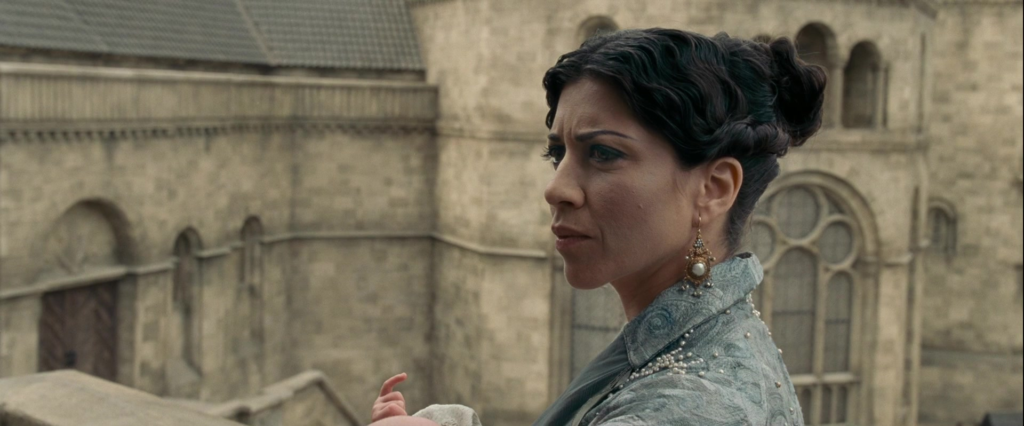
Miraz strides into the stables where the soldiers are dismounting and heads straight for the horse with the prisoner on it, covered by a cloth. “Wait, my lord,” says Glozelle, “It is not what you think.” “Then what is it?” asks Miraz. “We’re not exactly sure,” Glozelle replies, looking nervous. The cloth is pulled back and Miraz gasps at what he sees. “Impossible,” he murmurs. (Could this be a callback to Susan’s reaction to see Narnia for the first time and the White Witch’s reaction to Aslan’s resurrection in the last movie?) Then wheels start to turn in his head.
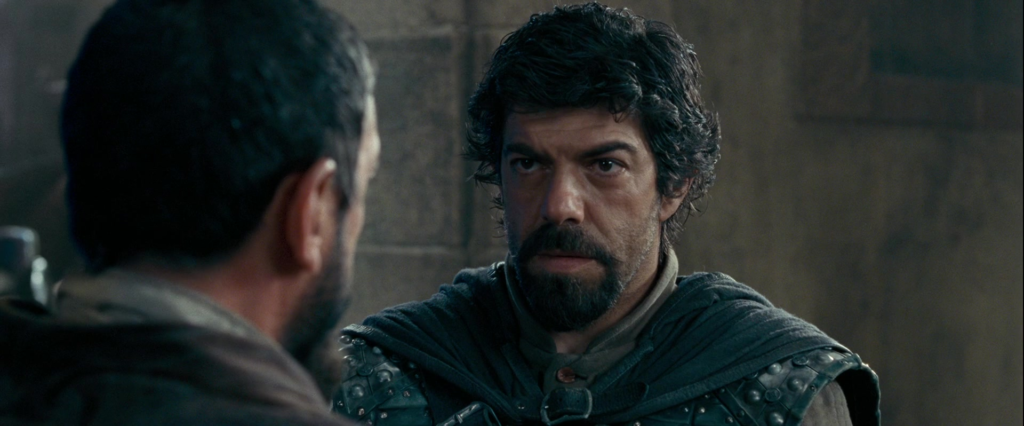
Meanwhile, a council is being held in the Telmarine council chamber. Many chairs in it are empty including the fancy one for the king. “I warned this council when it put its trust in Lord Miraz, there would be consequences,” declaims a lord named Sopespian (Damian Alcazar.) In the book, Lord Sopespian, like Glozelle, is initially a supporter of Miraz and only turns against him at the climax. Here he’s antagonistic towards him from the start. I think that change works well. As I’ve mentioned before, Glozelle and Sopespian are a bit of a random deus ex machina in the text. Another lord objects that they can’t accuse the lord protector of Narnia without proof. “How long are we going to hide behind that excuse?” grouses Lord Scythley (Simon Andreu), another council member. “Until every chair in this chamber is empty?” This is a reference to how Miraz has been discreetly killing off nobles who might support his nephew’s claim to the throne as Dr. Cornelius explains to Caspian in Chapter 5 of the book. The meaning isn’t immediately clear to someone who hasn’t read the source material but, to be fair, it’s not too hard to infer the meaning. Sadly, that’s not true of some other parts of this movie’s plot which are only understandable for book fans.
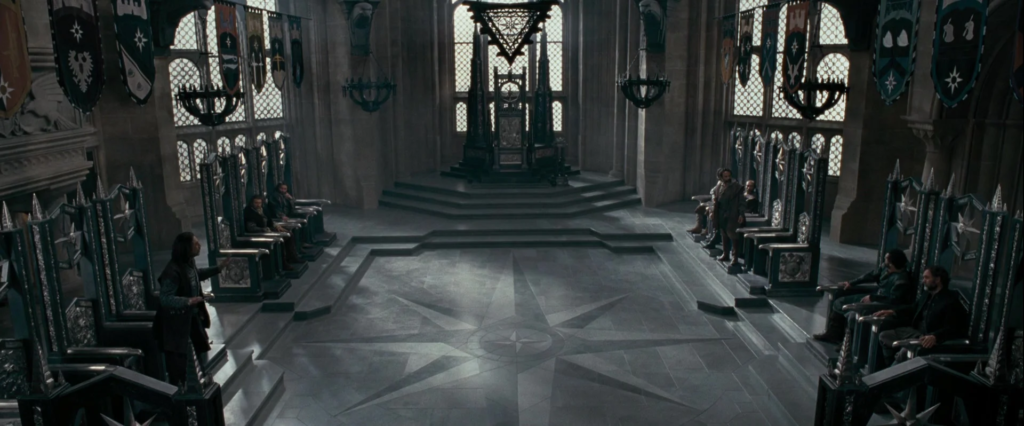
Miraz enters the room and takes his seat.
Miraz: Lords of the council, I apologize for being late. I wasn’t aware we were in session.
Sopespian: No doubt you were otherwise occupied.
Miraz: My lord?
Scythley: Ever since the death of Caspian the Ninth, you’ve behaved as if you were king and now it seems that behind these walls even Prince Caspian has gone missing!
Sopespian: My deepest condolences, Lord Miraz. Imagine losing your nephew, the heir to the throne, on the very night your wife has blessed you with a son.
Miraz: Thank you, Lord Sopespian. Your compassion is a boon in these troubled times.
What those words can’t convey on the screen is the hilariously sarcastic delivery of Damian Alcazar and Sergio Castellitto. The latter’s line readings are especially impressive considering his English language skills weren’t the best when this movie was being filmed and he sometimes needed a translator on set. Alcazar gives his character a smug smile and twinkling eyes that actually let you empathize with Miraz’s annoyance at him. Simultaneously, since we know Miraz is a bad guy, we kind of root for Sopespian. The animosity between these two evil characters is highly entertaining, definitely one of the most fun parts of any Narnia movie that’s not from the books.[5]Well, it’s kind of in the books but as I said, it’s not developed much and the dynamic between them is a bit different.
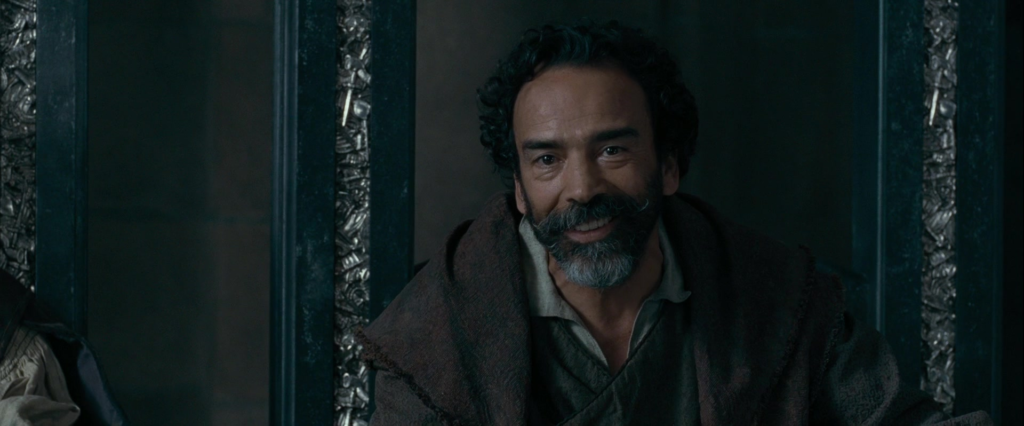
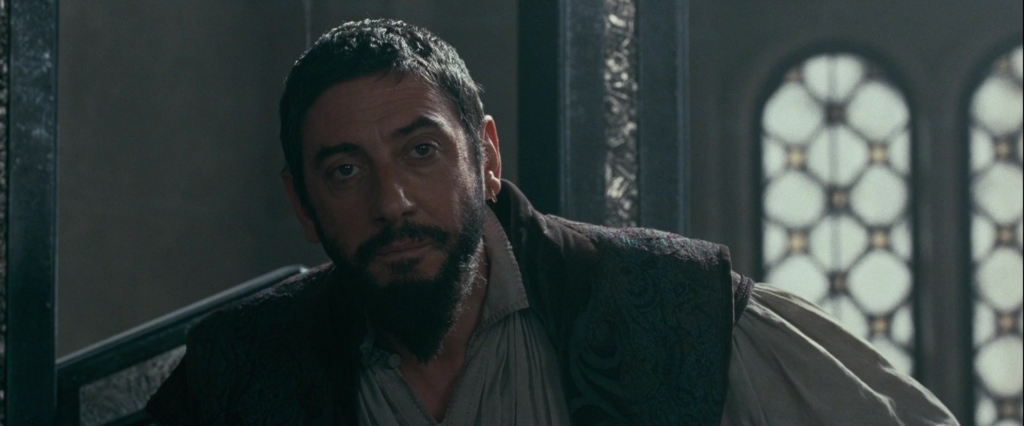
“I trust you can tell us how such a tragedy could have occurred,” Sopespian says. Right on cue, Glozelle demurely enters. “That is the most disturbing news of all,” says Miraz, “Our beloved Caspian was abducted. By Narnians!” The council scoffs at this. “You go too far, Miraz!” says Scythley. “You expect us to stand by while you blame such a blatant crime on fairy tales!” Miraz signals to Glozelle who opens the door, and two guards bring in the red dwarf from the forest, bound and gagged. The Telmarines gape at him. “You forget, my lords,” says Miraz, “Narnia was once a savage land. Fierce creatures roamed free. Much of our forefathers’ blood was shed to exterminate these vermin. Or so we thought.” Ironically, in his first scene in the book, Miraz is the one who insists that the Narnians are fairy tales to Caspian and forbids him to ever mention them again. Of course, that was in Caspian’s childhood, which this movie tragically cuts. (I’ll start to really explain why it’s tragic in my next post.) Of course, in the main part of the story, Miraz has to affirm the existence of the native Narnians since he’s waging war against them. Still, it’s sad that the part about him insisting they never existed had to be dropped from this adaptation. It’s a memorable detail. Anyway, back to his speech. “But while we’ve been bickering amongst ourselves, they’ve been breeding like cockroaches under a rock, growing stronger, watching us, waiting to strike!” On the last word, Miraz smacks the dwarf’s face, actually knocking his gag off. (Is that possible?) “And you wonder why we don’t like you,” the dwarf snarks.
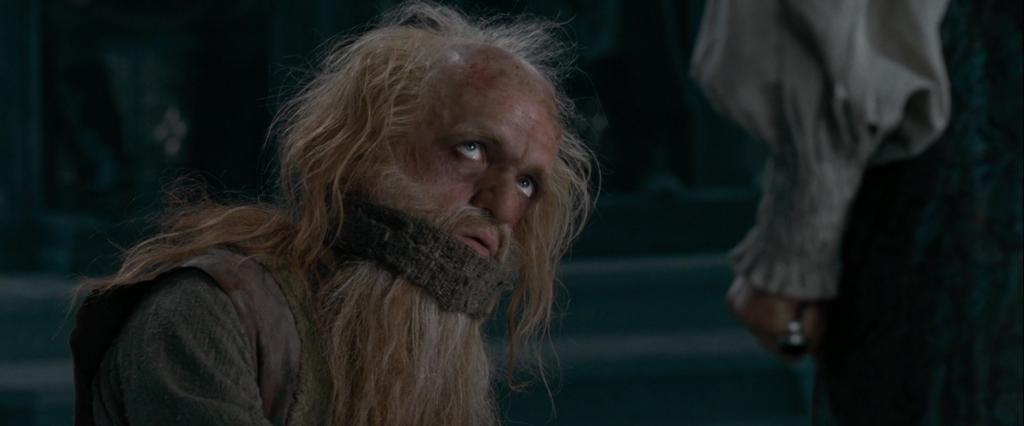
Miraz ignores this. “Well, I intend to strike back,” he says, “Even if I have to cut down the entire forest, I assure you, I will find Prince Caspian and finish what our ancestors began.” Here’s another place where I think you could reasonably argue that the movie improves on the book. The literary Miraz has few actual scenes and is easily the most boring villain in any Narnia book. To be fair, I believe C. S. Lewis intended him to be somewhat boring by the design; his mundane, realistic villain makes him something of a foil to the White Witch from the previous story. But that design doesn’t always make for the most fun reading. By dramatizing the way Miraz maneuvers himself from the position of Lord Protector to King of Narnia, something that is only summarized by Cornelius as having happened a long time ago in the book, this movie makes him much more threatening, especially coupled with Sergio Castellitto’s charismatic performance. We’ll see more scenes of how he uses the threat of the Narnians for his own political purposes later. This villain proves to hold up surprisingly well against Tilda Swinton’s White Witch from the previous movie.
Back at the island-oh, I should mention something. In both the books and the movies, Cair Paravel was originally on a peninsula, but it became an island by the time of Prince Caspian. Back at the island, Edmund finds evidence that Cair Paravel didn’t just fall into ruins after being abandoned but was attacked by catapults. Then he and Peter push aside a stone wall to reveal a secret door.

Peter pulls apart the rotting wood then he tears a strip of cloth from his shirt and wraps it around a stick to make a torch.

“Don’t suppose you have any matches, do you?” he asks Edmund. “No, but would this help?” his brother replies, taking out an electric torch from his satchel. This moment is both really funny and allows the filmmakers to avoid confusing American audiences who would call the device a flashlight.[6]Edmund will refer to it as a torch though in the last scene. Not that I’m complaining. It’ll be a really fun bit from the book. “You might have mentioned that a bit sooner,” says Peter, laughing. It’s nice that this scene shows him accepting this little moment of humiliation in good humor instead of having him be all angry and arrogant as the movie will later portray him.
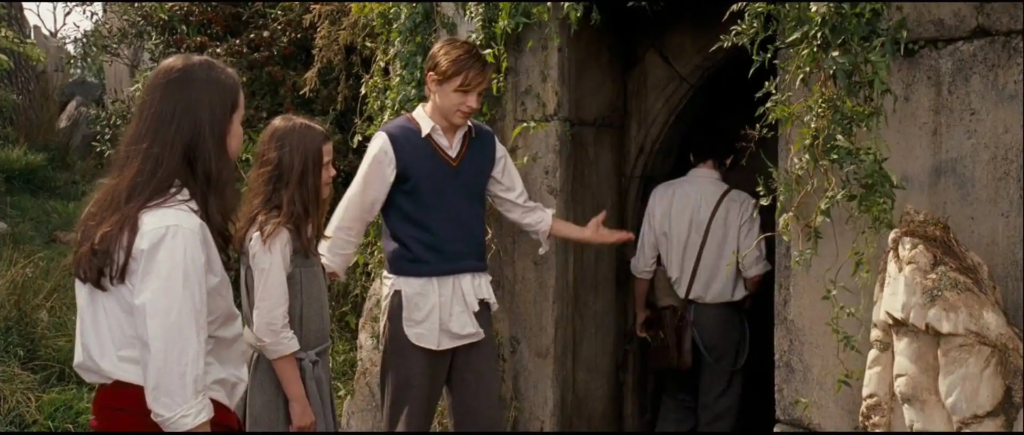
The Pevensies troop through the door and down a flight of stairs to an ancient treasure chamber. “I can’t believe it,” says Peter, “it’s all still here!” There are four treasure chests, each with a statue of one of the four siblings at the height of their Narnian reign. Edmund, Lucy and Susan rush over to their respective chest and open it.

“I was so tall!” says Lucy as she pulls out an old dress. “Well, you were older then,” says Susan. “As opposed to hundreds of years later when you’re younger,” says Edmund. I’d complain about him explaining the joke, but I love the humorous visual of him wearing a Narnian helmet with his school uniform. Actually, in a clever touch, the Pevensies have already abandoned parts of their uniforms and the girls’ hair has come unbraided, so they appear to be in halfway stage between their English selves and their Narnian selves in this scene.
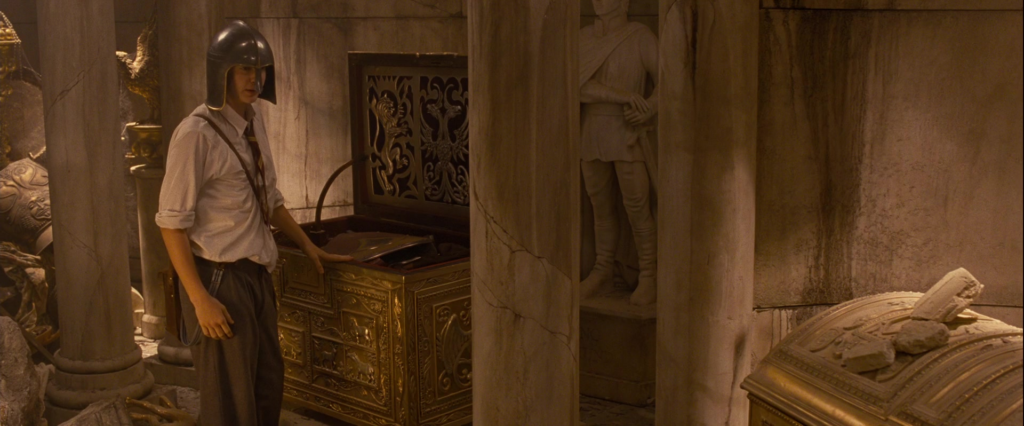
Although he was the one who seemed to want to return to Narnia the most, Peter is taking his time looking over his former treasure. First, he blows the dust off a golden disc[7]A shield maybe? with an image of Aslan’s face on it. Then he slowly and reverently approaches his chest with the statue of himself standing guard over it. His attention is momentarily distracted by Susan who has found her bow and arrows from Father Christmas in her treasure chest but not her enchanted horn. “I must have left it on my saddle the day we went back,” she says. Finally, Peter opens his chest and pulls out his sword. He reads part of the inscription aloud. “When Aslan bares his teeth, winter meets its death.” As you may remember, that was the prophecy that was never spoken in the previous movie. Better late than never, I suppose. Lucy wistfully recites another part of it. “When he shakes his mane, we shall have spring again.” There’s a moment of silence. In the book, after Peter unsheathes his sword, “the others all felt that he was really Peter the High King again.” Their silence indicates something a bit different in this version. “Everyone we knew,” says Lucy, “Mr. Tumnus and the Beavers…they’re all gone.” The children in Prince Caspian the book never seem disturbed by the revelation that coming back to Narnia centuries after their last visit means all their friends have long died. It arguably makes the story sadder and, to use a tired word, darker than it originally was. I wouldn’t say it’s untrue to the spirit of the Narnia books in general though.[8]One of them, The Silver Chair, has a character from this world return to Narnia and be shattered to find that a friend he knew as a strapping youth is now an old man at the point of death. “I think it’s time we found out what’s going on,” says Peter.
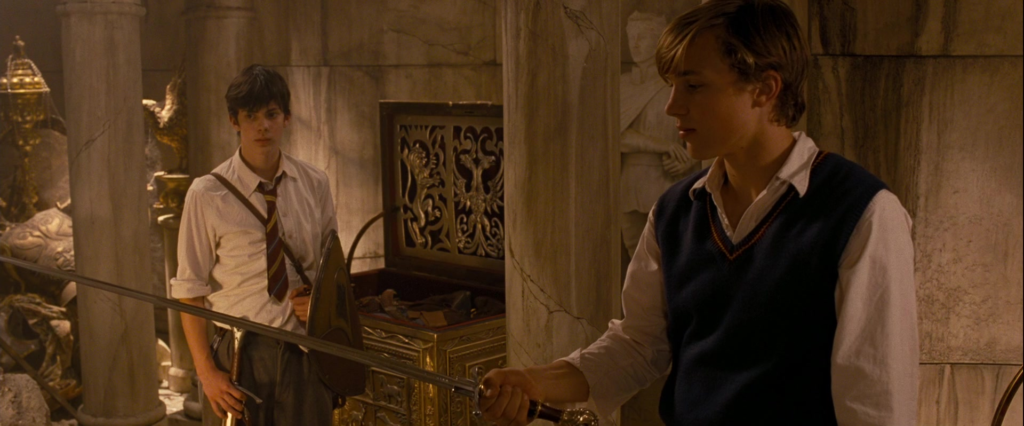
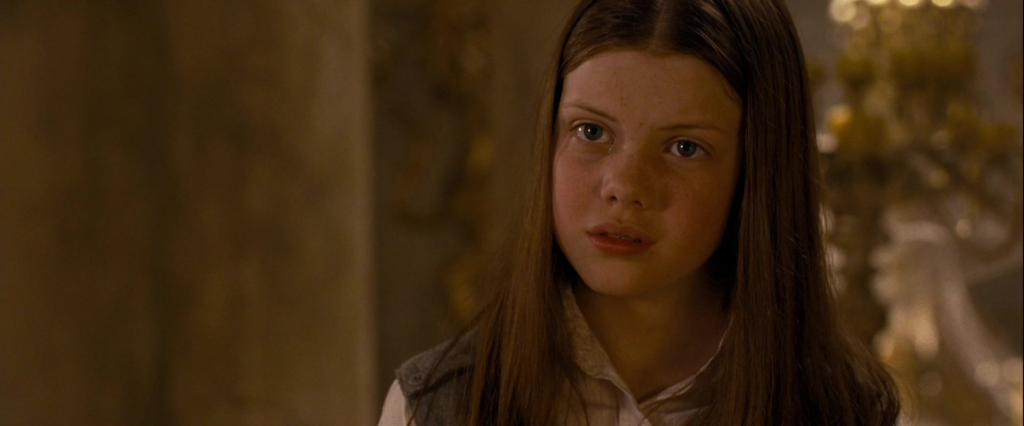
Outside, two Telmarine soldiers (stuntmen Mana Davis and Winham Hammond) are rowing in a boat up the coast by way of a river. With them is the bound and gagged dwarf. The dwarf’s name is Trumpkin by the way. That won’t be said in the dialogue until the next scene and in these recaps, I try to avoid saying names until their mentioned in the dialogue to replicate the experience of watching the movie but describing this whole scene without calling Trumpkin by name would just be a pain. One of the soldiers is unnerved by the dirty look the dwarf is giving him and both soldiers seem to be on edge. “Here’s far enough,” the one complaining about Trumpkin’s stare says. They pick him up and are about to throw him into the water. You may wonder why Miraz has had them take a prisoner all the way out here to drown him instead of doing the practical thing and killing him right away in some simpler manner. That was actually explained in the book. There the Telmarines believed that the woods around Cair Paravel’s ruins, as well as woods in general, were haunted by ghosts and ceremonially left certain prisoners there. This seems to be the implication in the movie too, given the soldiers’ jitteriness, but it’s not explained at all. Truth be told, this plot device was already a bit contrived in the book. C. S. Lewis’s reason for including it seems to have been that Trumpkin simply going to the island in search of the ancient kings and queen and then finding them would be boring, so he had to have him captured and taken there against his will.[9]Incidentally, Trumpkin also wasn’t captured by Miraz in the book but by a random seneschal. But it feels really contrived in this movie which never explains this weirdly specific form of execution. Sadly, that’s not the only plot point in the adaptation that viewers won’t understand if they haven’t read the book. Anyway, back to the scene. The soldiers barely lift Trumpkin before an arrow strikes their boat. They look up to see it came from Susan’s bow. She stands on the beach with her brothers and sister, all of them dressed in Narnian clothes. It’s a bit of a stretch that they would each find outfits their size just lying around the ancient ruins. (In the book, they spend most of the story in their school clothes.) But who cares? It’s a really cool moment to see them in Narnian garb for the first time in the movie. It really feels like the kings and queens of old have returned to rescue a Narnian from Telmarine oppression.
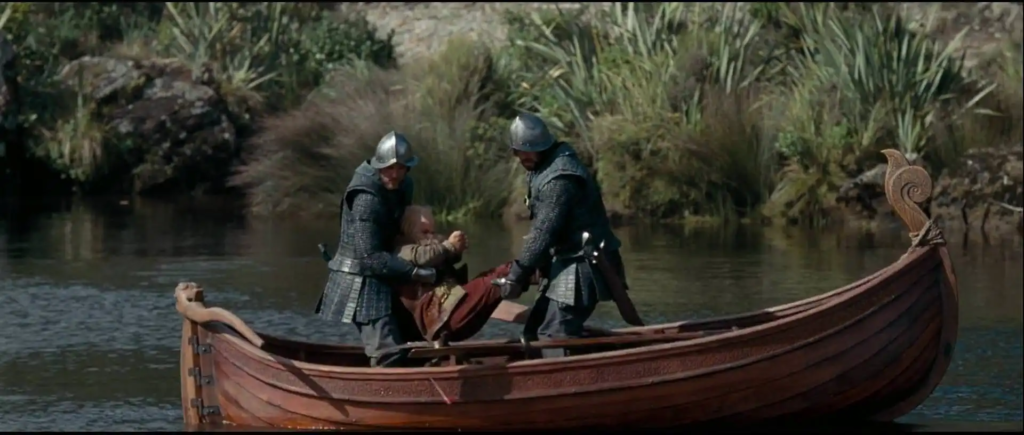

“Drop him,” orders Susan. The soldiers oblige my dropping Trumpkin into the water. Peter and Edmund dive in after him. Susan fires another arrow. One of them hits a soldier in the side. He and his companion jump out of the boat and swim away with all possible speed. (Again, this would make more sense if we knew they were afraid of ghosts.) Edmund drags their boat to the shore. Peter retrieves Trumpkin and Lucy cuts the sputtering dwarf’s bonds with her dagger.[10]The dagger wasn’t mentioned in the book by the way. I believe C. S. Lewis included it in The Lion, the Witch and the Wardrobe since Peter and Susan each got a weapon from Father Christmas. But … Continue reading
Trumpkin: “Drop him?!” That’s the best you can come up with?
Susan: A simple “thank you” would suffice.
Trumpkin: They were doing fine drowning me without your help!
Peter: Maybe we should have let them.
OK, I hate to say it but I’m really not a fan of the way this movie’s script writes Trumpkin. In the book at this point, he needs to be reassured several times that his rescuers aren’t ghosts, which is quite amusing, and is also very grateful to them. The movie makes him a grouch, mostly because…well, as we’ll see, Trumpkin is the Narnian who is most skeptical about Aslan and the Pevensies and naysaying sidekicks in fiction are expected to be bitterly sarcastic. The literary version of Trumpkin was quite sarcastic but in a cheerfully cynical way.[11]Imagine Han Solo in the first Star Wars movie if he didn’t start out as a mercenary but were a loyal ally from the start. Staying true to that would have made for a more original character and honestly would have fit in perfectly with this adaptation’s quippy action movie milieu.[12]For what it’s worth, director Andrew Adamson wrote the part specifically for Peter Dinklage, but I don’t think it would have been that hard for the actor to bring the book’s … Continue reading

Lucy: Why were they trying to kill you anyway?
Trumpkin: They’re Telmarines. That’s what they do.
Edmund: Telmarines? In Narnia?
Trumpkin: Where have you been for the last few hundred years?
Lucy: That’s a bit of a long story.
Susan hands Peter back his sword which he naturally dropped when diving into the water. Trumpkin notices it and his mouth falls open. “Oh, you’ve got to be kidding me,” he says. “You’re it?! You’re the kings and queens of old?!” It’s an odd aspect of this movie that people can immediately recognize the Pevensie’s Christmas gifts at a glance. I guess their oral legends included very specific physical descriptions of them and it never occurs to anyone that it could just be a sword or a horn that with a similar design. Anyway, Peter holds out his hand to shake. “High King Peter the Magnificent,” he says. Trumpkin just stares at the hand. “You probably could have left off the last bit,” opines Susan. Trumpkin laughs, looking and sounding more like his literary counterpart, and agrees. “Probably.” Peter draws his sword. “You might be surprised,” he says. “Oh, you don’t want to do that, boy,” says Trumpkin. While the movie has just made Peter insufferably full of himself and will do so later, it happily gives him a moment of humility now. “Not me,” he says and indicates Edmund instead. (It’s depressing that I have to point it out whenever Peter does something likeable in this adaptation.)[13]In the book, Peter offers to be the one to fight Trumpkin to prove his and siblings’ worth but Edmund objects that “It will be more of a sucks for him if I win, and less of a let-down for … Continue reading
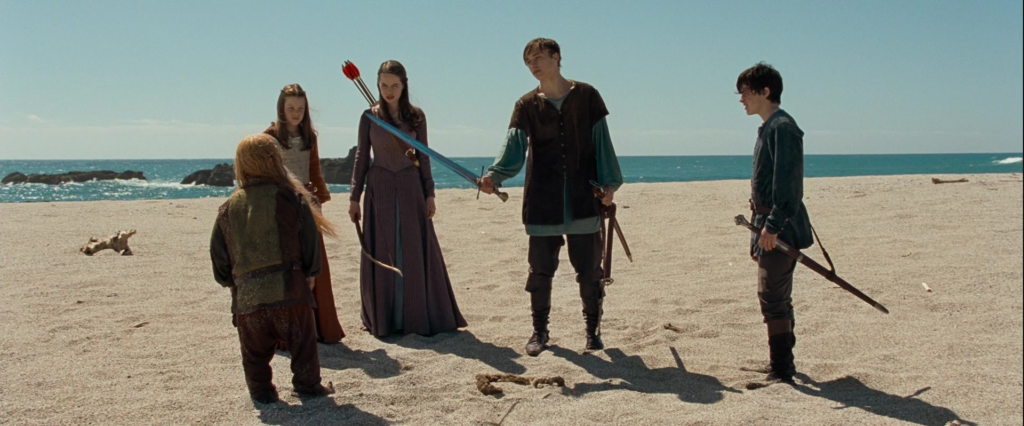
Edmund draws his blade and Peter lends Trumpkin his. For a moment, it looks like the sword will be too big for the dwarf and that this duel will be a bit of a mismatch. But then he almost chops Edmund’s head off and hits him in the eye.[14]I feel like it’s out of character for him to get so violent in a friendly match but oh well. Lucy actually calls out Edmund’s name in fear at that point though she quickly relaxes. In the book, it was Susan who was uncomfortable with the fight. (She “never could learn to like this sort of thing.”) But this adaptation, as we’ll see, makes her much less squeamish about violence. Anyway, before too long, Edmund disarms Trumpkin who falls to his knees and gapes at him, saying, “Beards and bedsteads!” In the book, that’s something of a mad libs catchphrase for the character. Variants include “horns and halibuts,” “whistles and whirligigs” and “giants and junipers.” Sadly, this is the only example of such an exclamation we get in the movie.
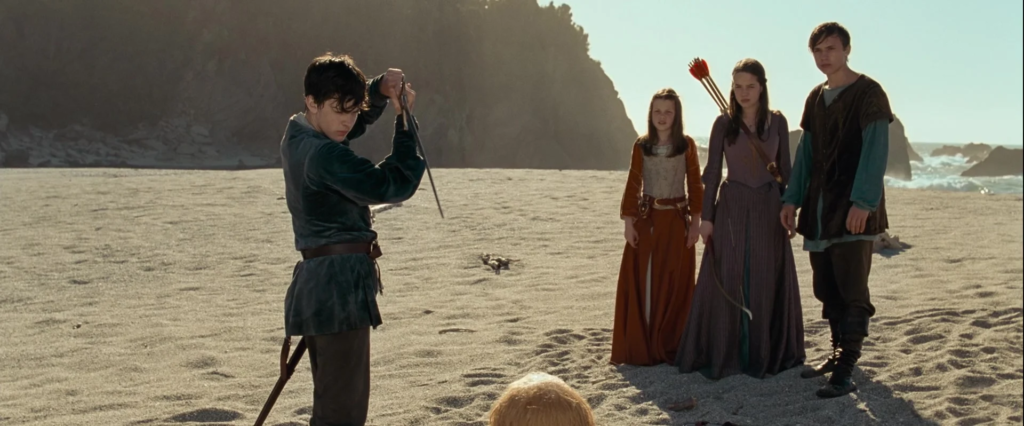
“Maybe that horn worked after all,” Trumpkin says. “What horn?” asks Susan. Before he answers, we cut to another scene. You’ll remember that the movie had Dr. Cornelius give Caspian a horn and tell him only to blow it at his greatest need but didn’t have him explain why. That was because the screenwriters wished to eliminate the original book’s nonlinear storytelling but wanted Susan’s horn being the thing that summoned her and her siblings back to Narnia to be a big revelation just as it is in the book. While Cornelius withholding the vital information didn’t make much sense in-universe, I appreciate the movie trying to be keep the book’s sense of mystery. But it does start-only start-to get annoying for it to hold back on explaining everything here.
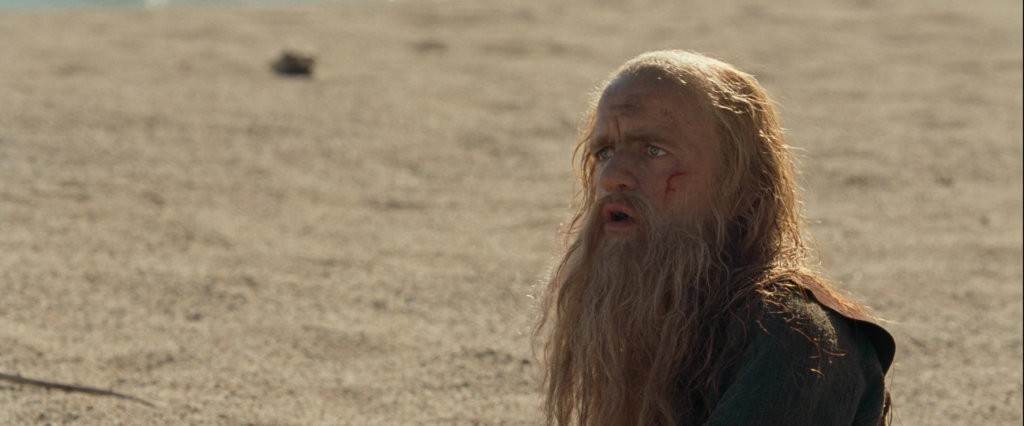
Next Week: Hey, We Still Haven’t Seen Caspian Since the First Scene, Have We?
References
| ↑1 | Many of whom are famous in their own countries but not in the UK or the US. |
|---|---|
| ↑2 | Perhaps they were actually thinking ahead to The Last Battle which pits King Tirian, a descendant of Caspian’s, against the Calormenes, the idea being that viewers would be less offended by villains looking and sounding generically non-Western if the hero isn’t generically Western. |
| ↑3 | Though I can understand why some Hispanics and Italians would be since Caspian, the one unambiguously sympathetic Telmarine, is the only one played by an English actor. |
| ↑4 | It’s a bit odd that they have images of eagles considering that the Telmarines are supposed to be enemies of beasts but, hey, eagles are birds of prey after all. |
| ↑5 | Well, it’s kind of in the books but as I said, it’s not developed much and the dynamic between them is a bit different. |
| ↑6 | Edmund will refer to it as a torch though in the last scene. Not that I’m complaining. It’ll be a really fun bit from the book. |
| ↑7 | A shield maybe? |
| ↑8 | One of them, The Silver Chair, has a character from this world return to Narnia and be shattered to find that a friend he knew as a strapping youth is now an old man at the point of death. |
| ↑9 | Incidentally, Trumpkin also wasn’t captured by Miraz in the book but by a random seneschal. |
| ↑10 | The dagger wasn’t mentioned in the book by the way. I believe C. S. Lewis included it in The Lion, the Witch and the Wardrobe since Peter and Susan each got a weapon from Father Christmas. But Lucy never showed a talent for using the dagger the way her sister did for archery or her brother did for swordplay, so he forgot it by the time he wrote Prince Caspian. |
| ↑11 | Imagine Han Solo in the first Star Wars movie if he didn’t start out as a mercenary but were a loyal ally from the start. |
| ↑12 | For what it’s worth, director Andrew Adamson wrote the part specifically for Peter Dinklage, but I don’t think it would have been that hard for the actor to bring the book’s Trumpkin to life. |
| ↑13 | In the book, Peter offers to be the one to fight Trumpkin to prove his and siblings’ worth but Edmund objects that “It will be more of a sucks for him if I win, and less of a let-down for us all if I fail.” |
| ↑14 | I feel like it’s out of character for him to get so violent in a friendly match but oh well. |
